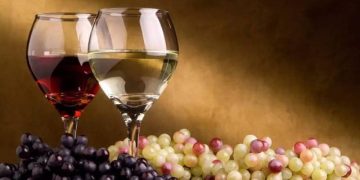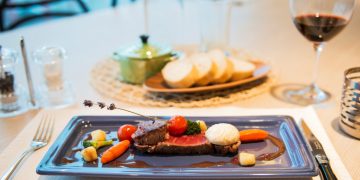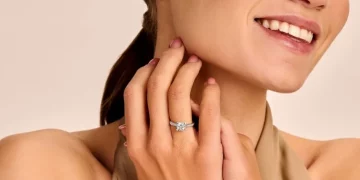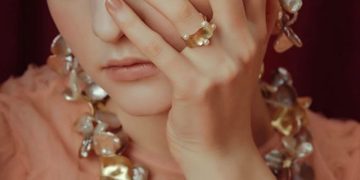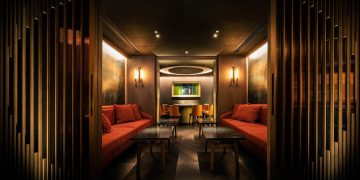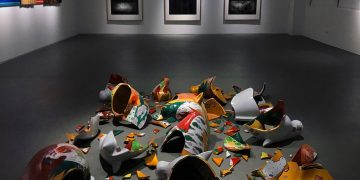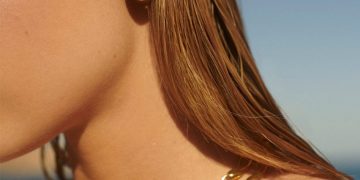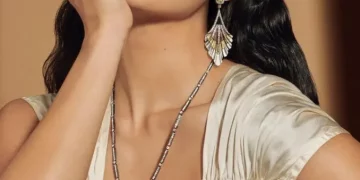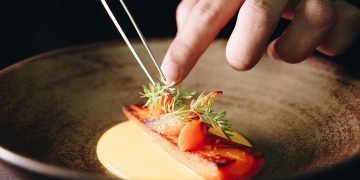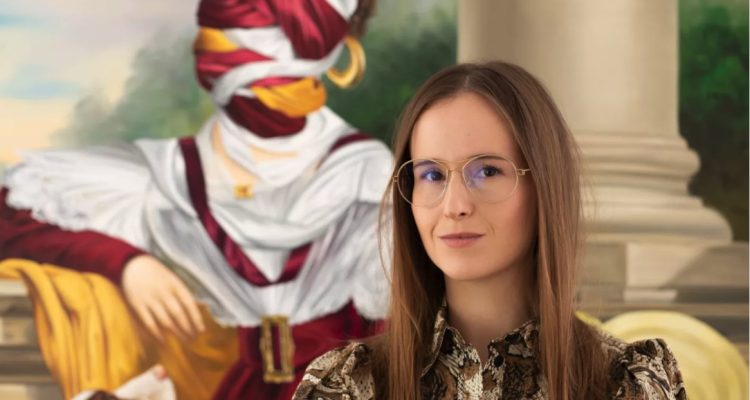In a Venetian palazzo, bookended by a gelataria and the cool marble aisles of Chiesa di Santa Maria della Visitazione, lies a hothouse of obfuscating flora. The galleries of Palazzo Cavanis, a 16th-century casa da statio perched on the edge of the Giudecca Canal, are currently home to “Locks with Leaves and Swelling Buds,” a selection of recent works by the Polish painter Ewa Juszkiewicz on view through 1 September. Presented by Fundación Almine y Bernard Ruiz-Picasso, the exhibition celebrates the artist’s passion for hiding women’s faces behind, amongst other things, outrageous bouquets of palm fronds and orchids.
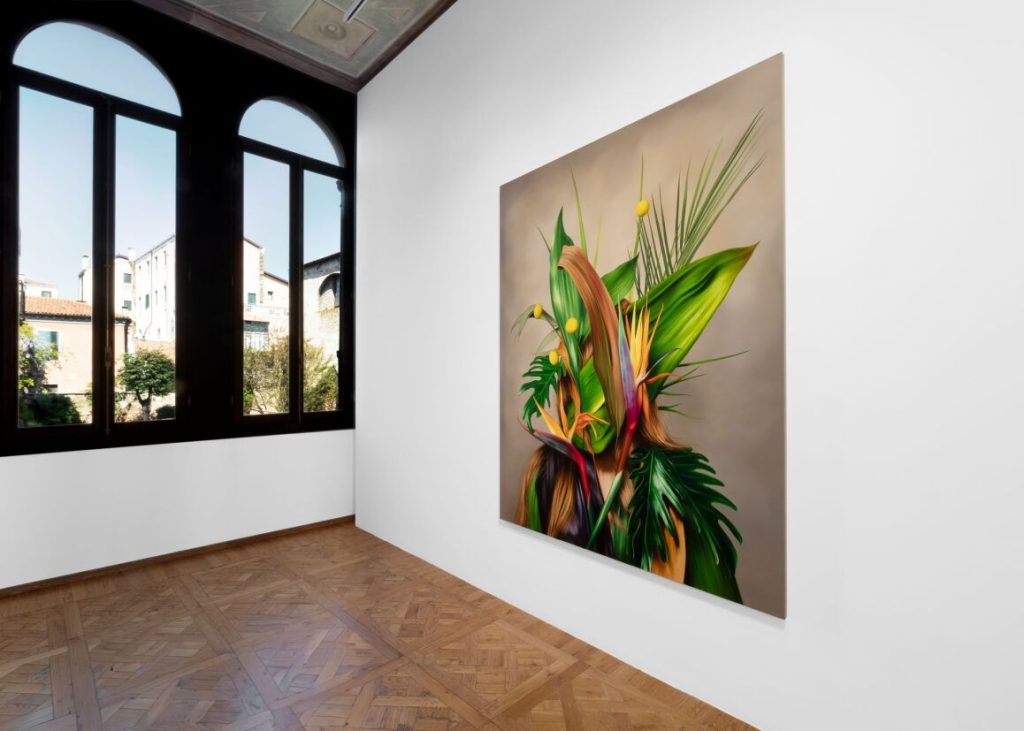
Over the past decade, Juskiewicz has created a body of work that plays with the entrenched historical approach to women’s portraits, from the Renaissance through to the 19th century, in which sitters were portrayed in what the artist describes as an “idealistic” fashion. In her paintings, however, the features of her female sitters are obliterated by plants, fruit, convoluted hair styles or tangles of cloth. In one dramatic new piece, Bird of Paradise (2023), she depicts a woman in non-specific period dress almost entirely enclosed in green, yellow and purple foliage. It’s a portrait of a feral lady.
In 18th- or 19th-century portraits, says Juskiewicz, men were represented as “very active. Looking at the work you could see who the person was, how rich he was, what he was doing in life, what career he had, and so on,” she tells me as we walk through the palazzo. “When you look at women’s portraits, sometimes you learn nothing about them. Even if they were someone very important.” Her paintings examine that anonymity.
While looking to the past, Juszkiewicz is also concerned with the present. She hopes that her paintings “answer some contemporary questions concerning the images of women.” In a time of social media, she says, such images are full of “issues and problems.” Her pictures evolve out of a curious combination of feminism, conceptualism and counter-intuitive history painting. Most of all, her approach sits in the surrealist tradition: “I wish to tell a new tale and create my own language: ambiguous, dense, natural and organic.”
Juszkiewicz was born in Gdańsk in 1984. Growing up in Communist Poland, she absorbed a range of influences, from historical architecture and art to contemporary fashion magazines. She later studied at the Academy of Fine Arts in Gdańsk and the Kraków Academy of Fine Arts.
Her practice is studious and intricate. She collects textiles, clothes, vintage jewellery and wigs during her research. In art, she says, hair in particular can be perceived in many different ways. “It is very sensual but can be dangerous. Hair has a lot of mystery.” And then there are the flowers, ferns, sprigs and sprays. “I regularly buy plants and often dry them and keep them in the studio.”
Her paintings refer to the history of fashion, but she is “also very interested in contemporary fashion, designers like Iris Van Herpen and Comme des Garçons.” Her own body is another reference: some of her works could be considered self-portraits (albeit ones imagined through the prism of centuries past).
Her subjects walk a line between the human and the inhuman, an approach that has proved hugely popular. Louis Vuitton recently transformed a 2021 oil painting, Ginger Locks, into an “Artycapucines” handbag. And at Sotheby’s London last year, Untitled (after Joseph Wright)doubled its high estimate, selling for £609,600. So, have collectors and patrons asked her to paint their portrait, albeit concealed by some exotic and eccentric means? “Yes. But I never do it,” she says. “I’ve never been interested in doing commissions.”
Recent work marks a further development in her project, as Juszkiewicz reimagines historical portraits, including those by celebrated female artists, such as Élisabeth Vigée le Brun, court painter to Marie Antoinette. “I love her painting technique, but on the other hand she was also painting in an idealistic convention.” Included in the Venice selection is a volte-face of Le Brun’s 1784 masterpiece The Comtesse de Gramont Caderousse Gathering Grapes, which hangs in the Nelson-Atkins Museum of Art in Kansas City. In the new painting the grapes overwhelm the Comtesse.
Such works are not copies, Juszkiewicz explains, but “reminders” of the originals. “I’m not trying to reproduce exactly. I just want to have the spirit and feeling of the history.” Her fondness for time-travel extends to her choice of venue. “We are in a beautifully restored palazzo. And I really like presenting my works in historical places, I like this dialogue with the past. I prefer to show in this kind of space, rather than a white cube gallery.”
Juszkiewicz’s gallerist, Almine Rech, acknowledges both the commercial appeal of her work and the unusual combination of talents required to create it. “Some people immediately fall in love with her work, it’s true that it creates that. But I met her five years ago and she was totally unknown. What I liked is that it’s related to historical paintings – she has the skills – but she’s also a conceptual painter.” And that blend is particularly rare, says Rech.
Juszkiewicz, meanwhile, considers her work to be a synthesis of the personal and the scholastic. “I tell my own story, which is surreal, strange and grotesque,” she says. “I challenge channels of female beauty and expose what was often hidden behind the art historical canon: women’s emotions, wildness, vitality.”







